Design and Performance Evaluation of eLoran Monitoring System
Abstract
:1. Introduction
2. Principle and Structure
2.1. Principle of eLoran Time Service System
2.2. Near-Field Monitoring Station
2.3. Far-Field Monitoring Station
- The time-frequency traceability keeping unit realizes time traceability to China standard time UTC (NTSC) through BDS (BeiDou Navigation Satellite System) common-view comparison, and provides a high-precision 1PPS reference signal (measurement reference), a 10 MHz frequency standard signal, and UTC time code information;
- The BPL monitoring receiver outputs a 1PPS timing signal, a 10MHz frequency calibration signal, and time code data information by receiving a BPL signal;
- The time interval counter receives the time difference data by measuring the 1PPS and reference 1PPS output from the BPL monitoring receiver, and receives the time code monitoring comparison data by comparing the time code information;
- The monitoring receiver transmits the time difference data and time code data obtained from the measurement comparison to the monitoring data processing center through the network.
2.4. Data Processing Center
3. Near-Field Monitoring Station Performance Analysis
3.1. Transmission Control Precision Calculation Method
3.2. Transmission Control Precision Data Analysis
4. Far-Field Monitoring Station Performance Analysis
5. Integrity Monitoring Analysis
5.1. Time Difference Prediction Model
5.2. Predictive Performance Analysis
5.3. Thresholds for Integrity Judgments
6. Conclusions
Author Contributions
Funding
Institutional Review Board Statement
Informed Consent Statement
Data Availability Statement
Conflicts of Interest
References
- Enhanced Loran (Eloran) Definition Document, Version 0.1. Available online: https://rntfnd.org/wp-content/uploads/eLoran-Definition-Document-0-1-Released.pdf (accessed on 8 May 2024).
- Minimum Performance Standards for Marine eLORAN Receiving Equipment Radio Technical Commission for Maritime Services. Available online: https://rtcm.myshopify.com/collections/maritime-navigation-equipment-standards/products/copy-of-differential-gnss-package-both-of-the-current-standards-10402-3-and-10403-3 (accessed on 8 May 2024).
- U.S. Coast Guard and the U.S. Coast Guard Auxiliary. Loran-C User Handbook. Available online: https://www.loran.org/otherarchives/1992%20Loran-C%20User%20Handbook%20-%20USCG.pdf (accessed on 8 May 2024).
- Lo, S.; Enge, P. Data transmission using LORAN-C. In Proceedings of the International Loran Association 29th Annual Meeting, Washington, DC, USA, 12–15 November 2000. [Google Scholar]
- SAE9990; Transmitted Enhanced Loran (eLoran) Signal Standard. SAE International: Warrendale, PA, USA, 2018. Available online: https://www.sae.org/standards/content/sae9990/ (accessed on 19 August 2024).
- SAE9990/1; Transmitted Enhanced Loran (eLoran) Signal Standard for Tri-State Pulse Position Modulation. SAE International: Warrendale, PA, USA, 2018. Available online: https://www.sae.org/standards/content/sae9990/1// (accessed on 19 August 2024).
- SAE9990/2; Transmitted Enhanced Loran (eLoran) Signal Standard for 9th Pulse Modulation. SAE International: Warrendale, PA, USA, 2018. Available online: https://www.sae.org/standards/content/sae9990/2// (accessed on 19 August 2024).
- Offermans, G.W.A.; Helwig, A.W.S. Integrated Navigation System eurofix: Vision, Concept, Design, Implementation & Test. Ph.D. Thesis, Delft University of Technology, Delft, The Netherlands, 2003. [Google Scholar]
- Willigen, D.V.; Offermans, G.W.A.; Helwig, A.W.S. EUROFIX: Definition and Current Status. In Proceedings of the IEEE Position Location & Navigation Symposium, Palm Springs, CA, USA, 20–23 April 1996; pp. 101–108. [Google Scholar] [CrossRef]
- ITU-R. P.368-9: Ground-Wave Propagation Curves for Frequencies between 10 kHz and 30 MHz. 2007. Available online: https://www.itu.int/rec/R-REC-P.368/en (accessed on 30 September 2020).
- Computational Methods of LW Ground-Wave Transmission Channels, F0130, SJ 20839-2002, People’s Republic of China Electronics Industry Standard. Available online: https://et.wanfangdata.com.cn/bz/Standard/Detail?standardId=SJ%2020839-2002 (accessed on 15 May 2024).
- EU eLoran Efforts Sharpen While U.S. Requirements Study Continues. Available online: https://insidegnss.com/eu-eloran-efforts-sharpen-while-u-s-requirements-study-continues/ (accessed on 20 April 2019).
- Li, S.F.; Wang, Y.L.; Hua, Y.; Xu, Y.L. Research of Loran-C data demodulation and decoding technology. Chin. J. Sci. Instrum. 2012, 33, 1407–1413. [Google Scholar]
- Yang, C.; Li, S.; Hu, Z. Analysis of the Development Status of eLoran Time Service System in China. Appl. Sci. 2023, 13, 12703. [Google Scholar] [CrossRef]
- Offermans, G.; Bartlett, S.; Schue, C. Providing a Resilient Timing and UTC Service Using eLoran in the United States: Resilient timing using eLoran. Navigation 2017, 64, 339–349. [Google Scholar] [CrossRef]
- Yuan, J.; Yan, W.; Li, S.; Hua, Y. Demodulation Method for Loran-C at Low SNR Based on Envelope Correlation–Phase Detection. Sensors 2020, 20, 4535. [Google Scholar] [CrossRef]
- Yang, S.H.; Lee, C.B.; Lee, Y.K.; Lee, J.K. Accuracy Improvement Technique for Timing Application of LORAN-C Signal. IEEE Trans. Instrum. Meas. 2011, 60, 2648–2654. [Google Scholar] [CrossRef]
- Wang, X.Y.; Zhang, S.F.; Sun, X.W. The Additional Secondary Phase Correction System for AIS Signals. Sensors 2017, 17, 736. [Google Scholar] [CrossRef]
- Son, P.W.; Park, S.H.; Seo, K.; Han, Y.; Seo, J. Development of the Korean eLoran testbed and analysis of its expected positioning accuracy. In Proceedings of the 19th IALA Conference, Incheon, Republic of Korea, 27 May–2 June 2018. [Google Scholar]
- Lo, S.C.; Peterson, B.B.; Hardy, T.; Enge, P.K. Improving Loran coverage with low power transmitters. J. Navig. 2010, 63, 23–38. [Google Scholar] [CrossRef]
- Li, Y.; Hua, Y.; Yan, B.R.; Guo, W. Analysis on Time Variation Analysis of BPL Long Wave Time Service Signal Transmission Delay. J. Astronaut. Metrol. Meas. 2019, 39, 12–16. [Google Scholar]
- Rhee, J.H.; Seo, J. eLoran Signal Strength and Atmospheric Noise Simulation over Korea. J. Position. Navig. Timing 2013, 2, 101–108. [Google Scholar] [CrossRef]
- Yan, B.; Li, Y.; Guo, W.; Hua, Y. High-Accuracy Positioning Based on Pseudo-Ranges: Integrated Difference and Performance Analysis of the Loran System. Sensors 2020, 20, 4436. [Google Scholar] [CrossRef] [PubMed]
- Lo, S.C.; Peterson, B.B.; Enge, P.K.; Swaszek, P. Loran Data Modulation: Extensions and Examples. IEEE Trans. Aerosp. Electron. Syst. 2007, 43, 628–644. [Google Scholar] [CrossRef]
- Yan, W.; Zhao, K.; Li, S.; Wang, X.; Hua, Y. Precise Loran-C Signal Acquisition Based on Envelope Delay Correlation Method. Sensors 2020, 20, 2329. [Google Scholar] [CrossRef] [PubMed]
- Hu, A.P.; Gong, T. Research Status and Progress on the Enhance Loran-C Navigation Technology. Mod. Navig. 2016, 1, 74–78. [Google Scholar]
- Li, Y.; Hua, Y.; Yan, B.R.; Guo, W. Experimental Study on a Modified Method for Propagation Delay of Long Wave Signal. IEEE Antennas Wirel. Propag. Lett. 2019, 18, 1719. [Google Scholar] [CrossRef]
- Safár, J.; Lebekwe, K.C.; Williams, P. Accuracy Performance of eLORAN for Maritime Applicaations. Annu. Navig. 2010, 16, 109–121. [Google Scholar]
- Li, S.F.; Wang, Y.L.; Hua, Y.; Yuan, J.B. Loran-C Signal Fast Acquisition Method and Its performance Analysis. J. Electron. Inf. Technol. 2013, 35, 2175–2179. [Google Scholar] [CrossRef]
- GBT 14379-1993; Generic Specification Loran-C System. The State Bureau of Quality and Technical Supervision; 1993. Available online: https://std.samr.gov.cn/gb/search/gbDetailed?id=Uu8Zes3Ntyg=&mode=p (accessed on 15 May 2024).
- Davis, J.A.; Shemar, S.L.; Whibberley, P.B. A Kalman filter UTC (k) prediction and steering algorithm. In Proceedings of the 2011 Joint Conference of the IEEE International Frequency Control and the European Frequency and Time Forum (FCS) Proceedings, San Francisco, CA, USA, 2–5 May 2011; IEEE: Piscataway, NJ, USA, 2011; pp. 1–6. [Google Scholar]
- Luzar, M.; Korbicz, J.; Sobolewski, Ł.; Korbitcz, J. Prediction of corrections for the Polish time scale UTC (PL) using artificial neural networks. Bull. Pol. Acad. Sci. Tech. Sci. 2013, 61, 589–594. [Google Scholar] [CrossRef]
- Li, X.H.; Wu, H.T.; Gao, H.J.; Bian, Y.J. Clock disciplined method by using Kalman filter. Control Theory Appl. 2003, 20, 551–554. [Google Scholar]
- Ren, Y.; Li, X.-H.; Xue, Y.; Dong, R. Application of Kalmen filter for steering UTC(Lab) to UTC. In Proceedings of the 2014 IEEE International Frequency Control Symposium (FCS), Taipei, Taiwan, 19–22 May 2014; pp. 1–3. [Google Scholar] [CrossRef]
- Lin, X.; Luo, Z.-C. A new noise covariance matrix estimation method of Kalman filter for satellite clock errors. Acta Phys. Sin. 2015, 64, 080201. [Google Scholar] [CrossRef]



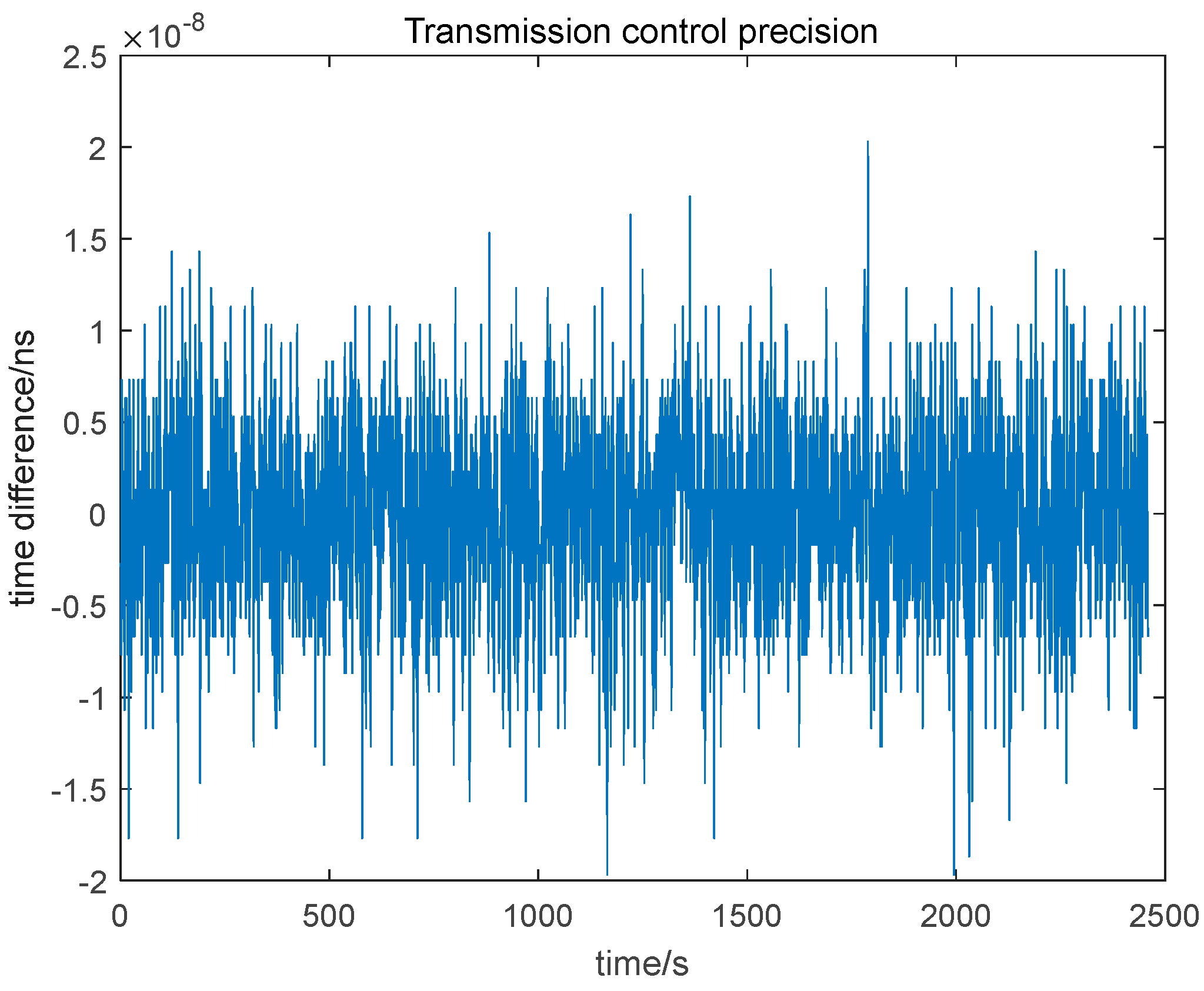
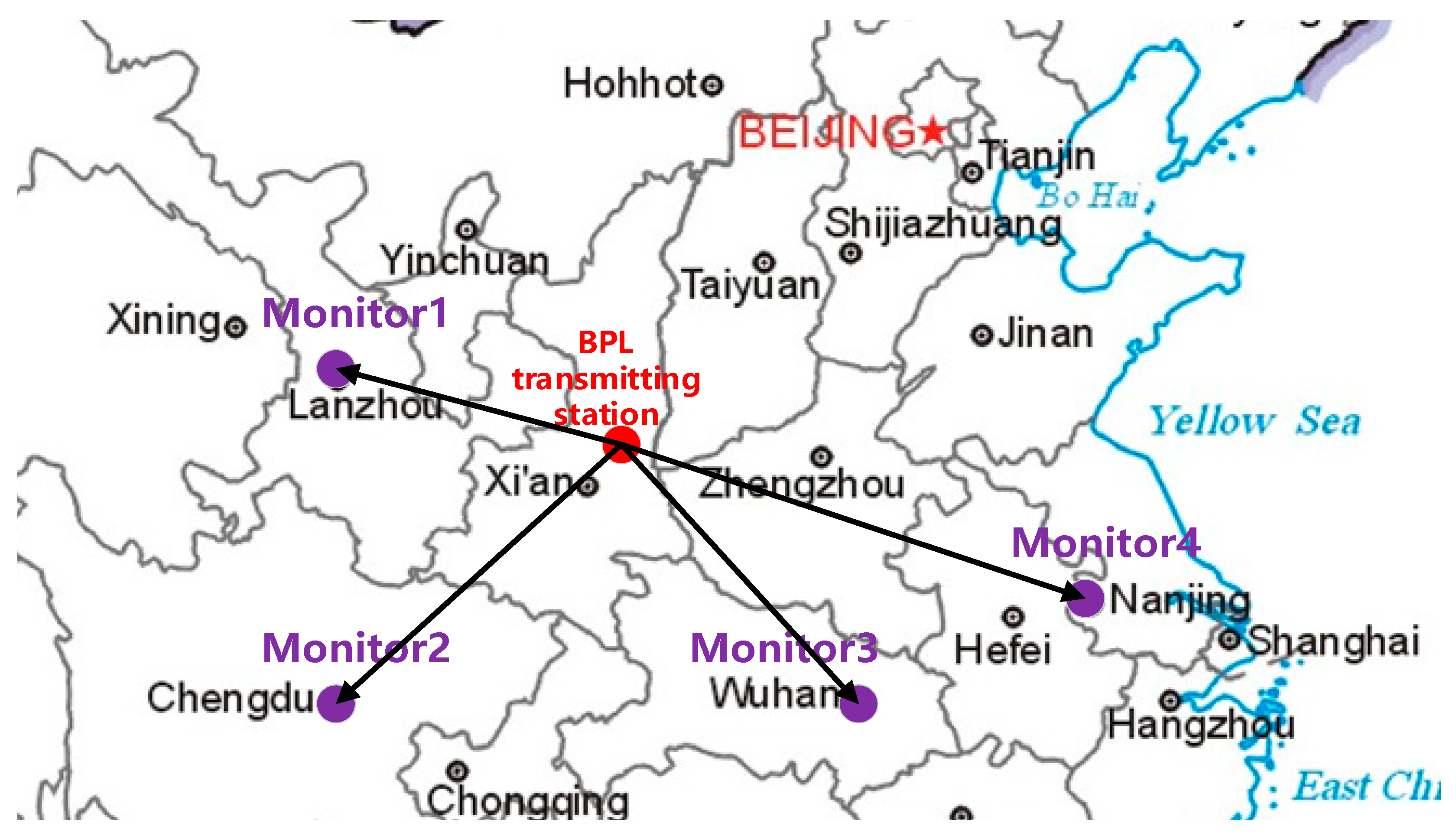
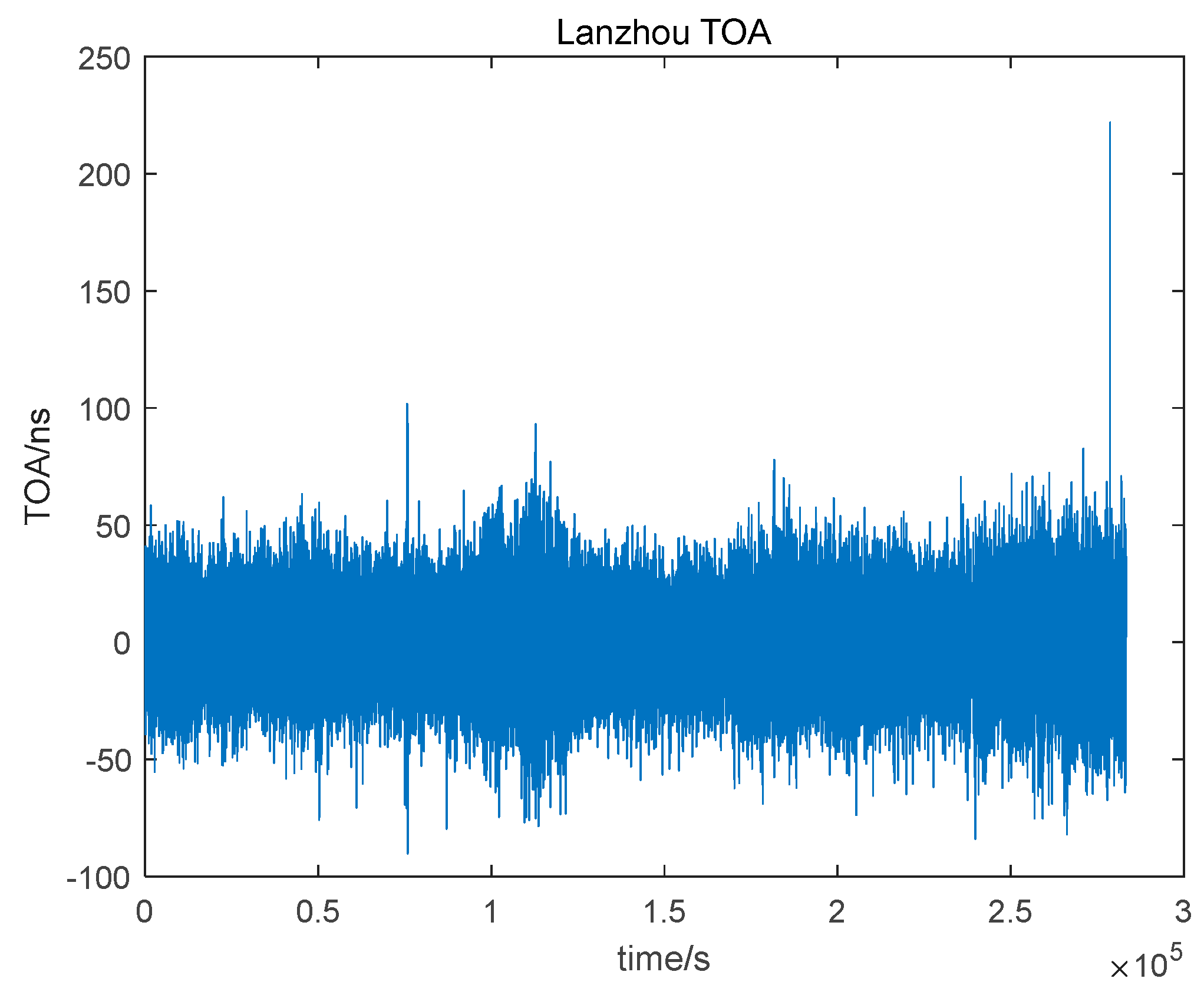

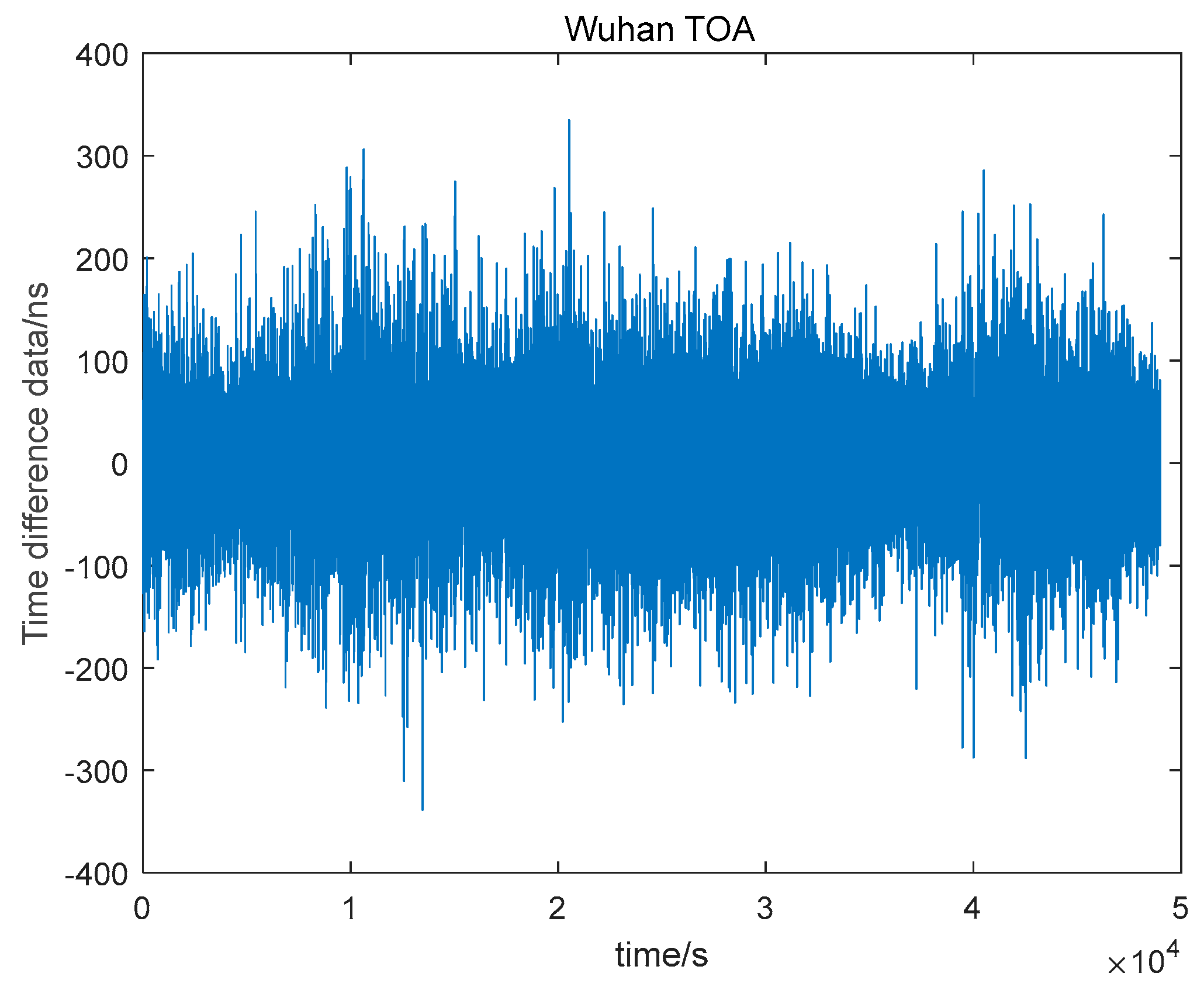
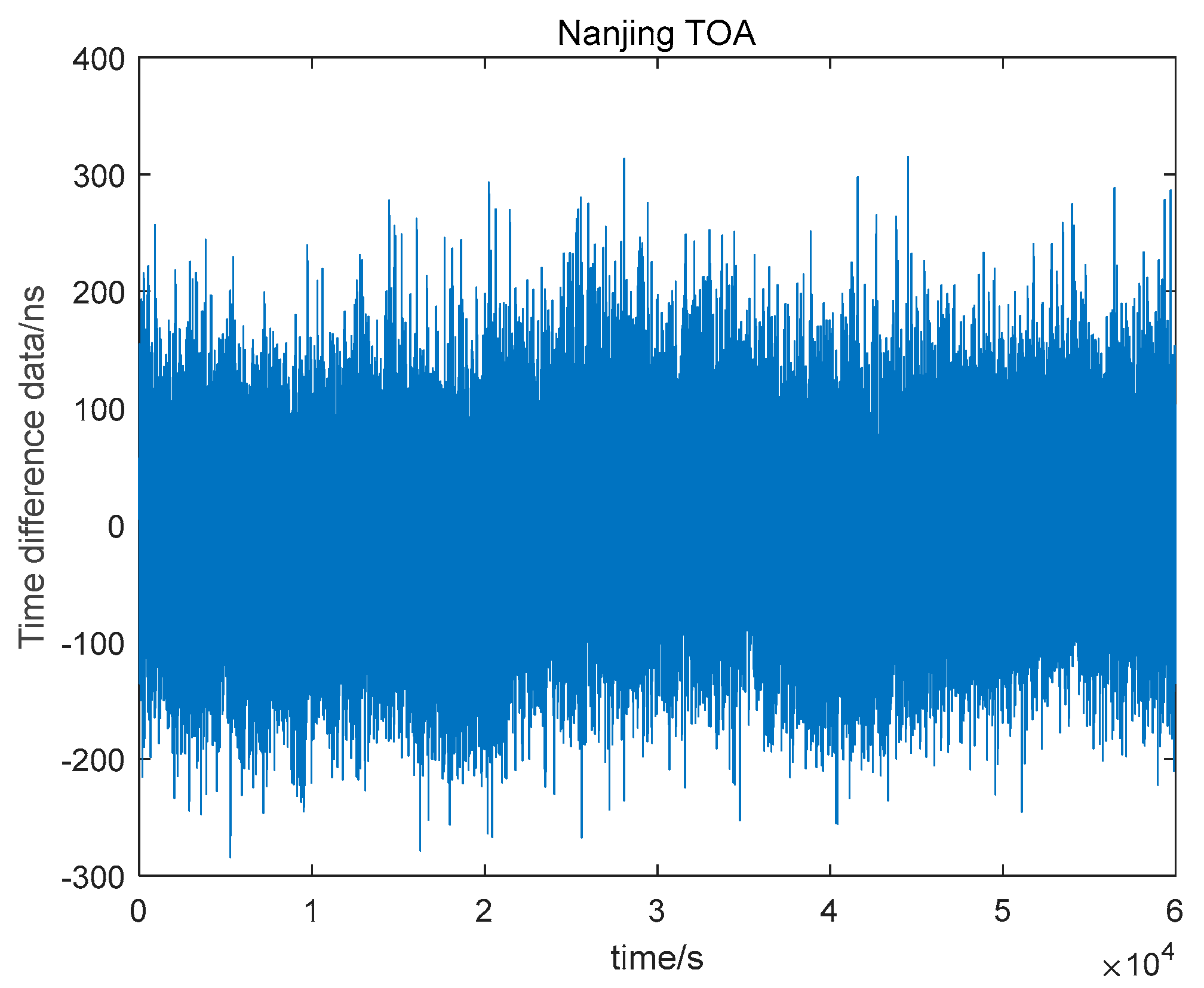
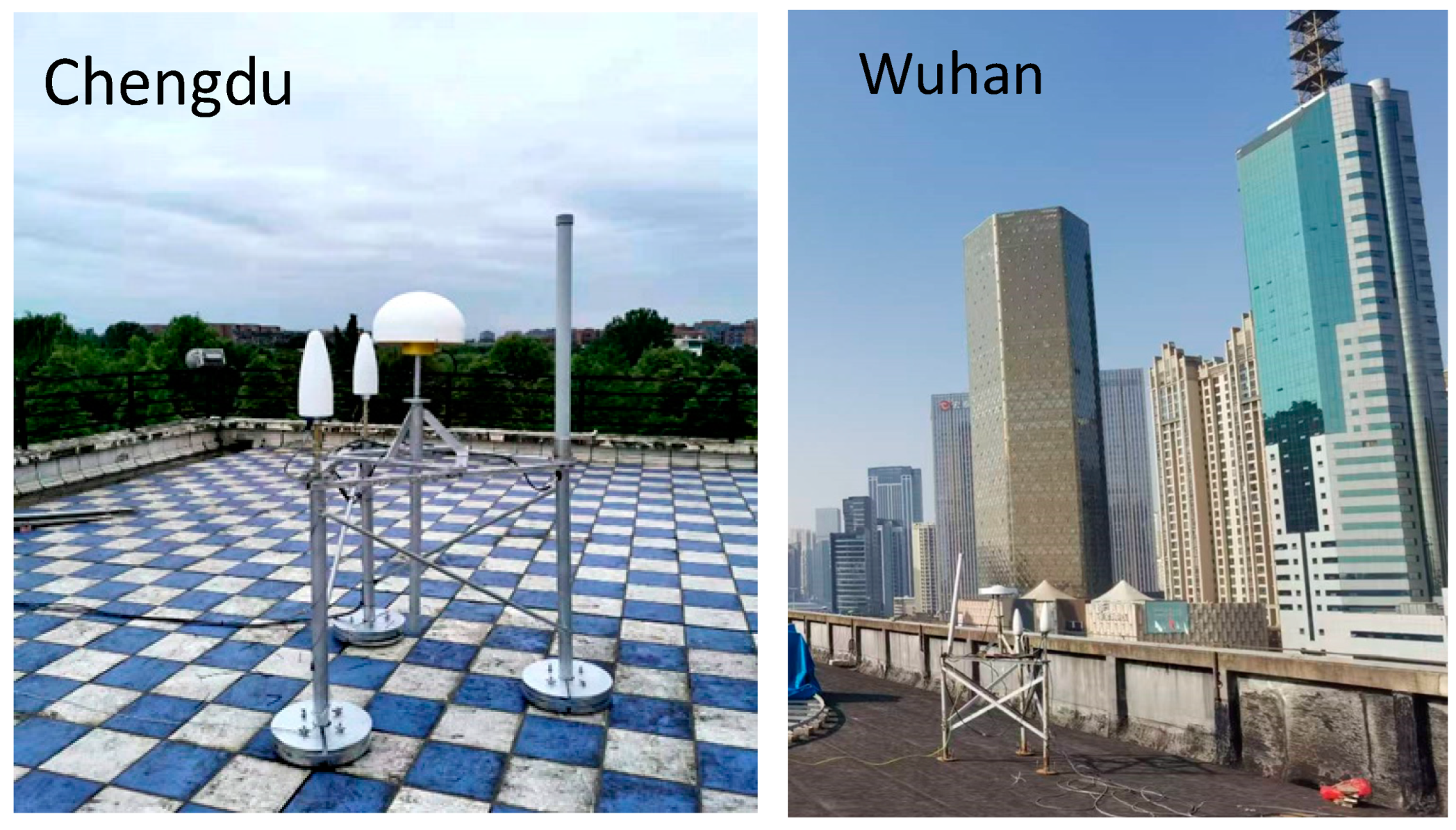

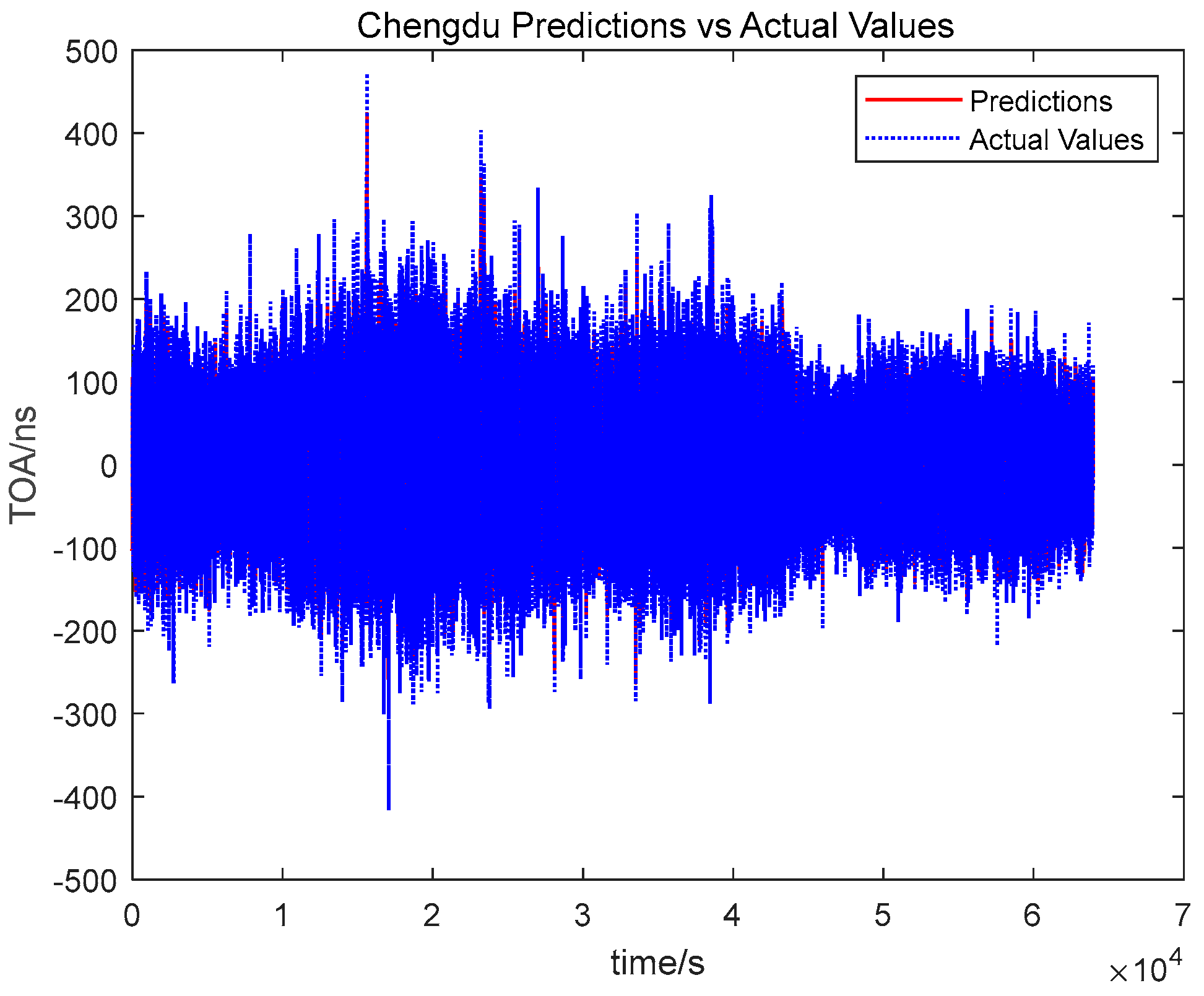
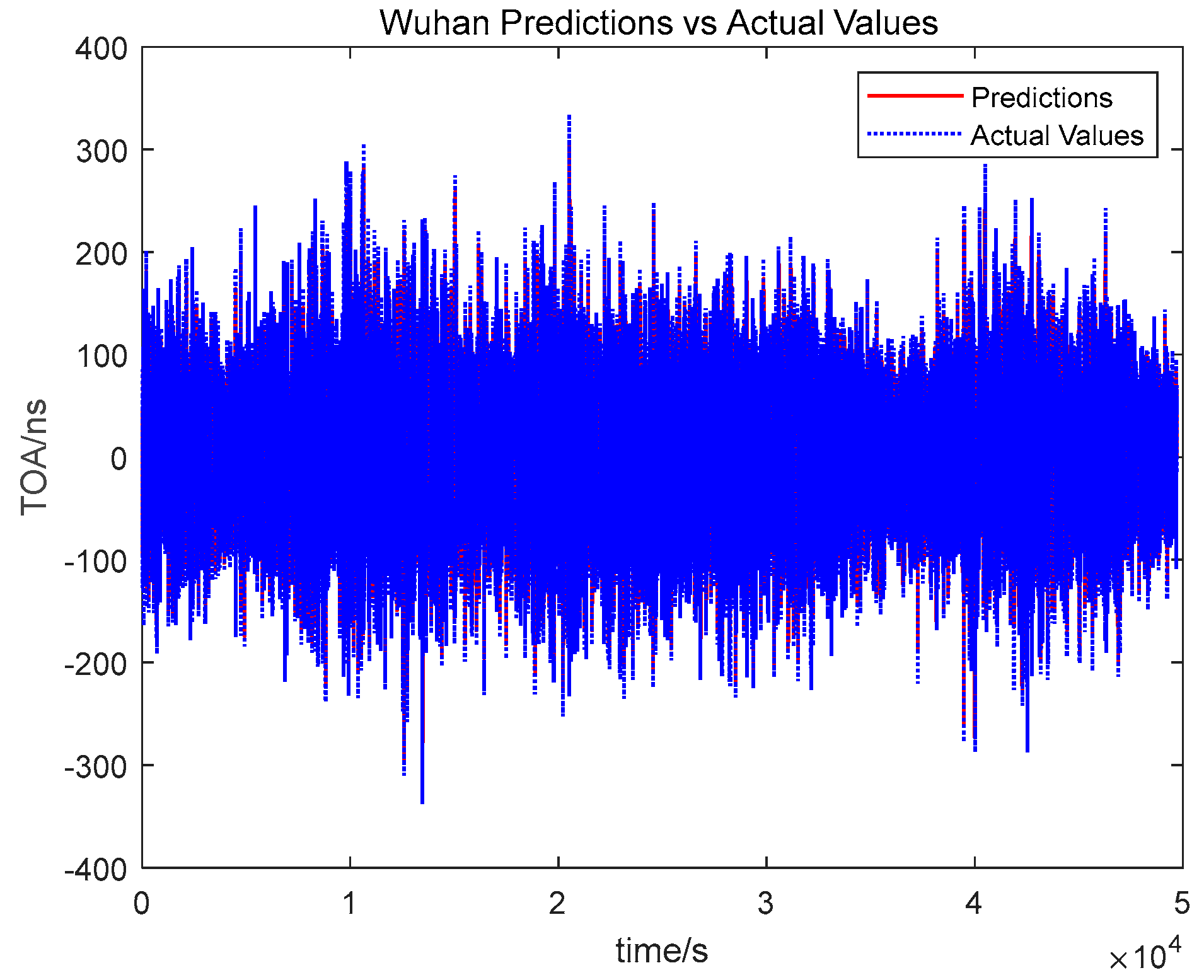
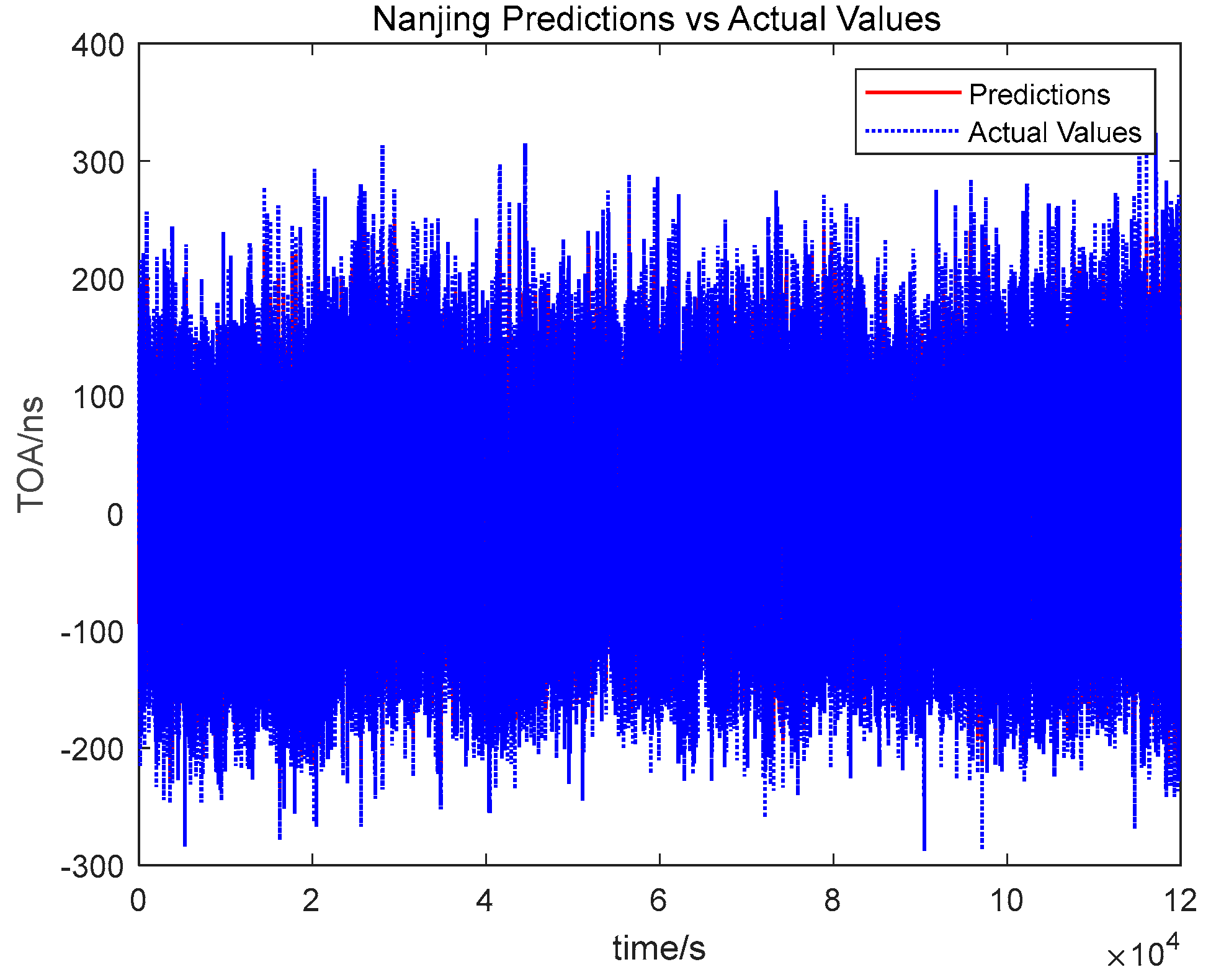
| Serial Number | Location | Distance from BPL |
|---|---|---|
| 1 | Lanzhou | 527 km |
| 2 | Chengdu | 700 km |
| 3 | Wuhan | 675 km |
| 4 | Nanjing | 861 km |
| Serial Number | Location | Distance from BPL | STD of TOA |
|---|---|---|---|
| 1 | Lanzhou | 527 km | 16.2 ns |
| 2 | Chengdu | 700 km | 65.4 ns |
| 3 | Wuhan | 675 km | 66.6 ns |
| 4 | Nanjing | 861 km | 70.1 ns |
| Serial Number | Location | STD of Actual TOA | STD of Predicted TOA |
|---|---|---|---|
| 1 | Lanzhou | 16.2 ns | 14.5 ns |
| 2 | Chengdu | 65.4 ns | 54.7 ns |
| 3 | Wuhan | 66.6 ns | 61.8 ns |
| 4 | Nanjing | 70.1 ns | 58.2 ns |
Disclaimer/Publisher’s Note: The statements, opinions and data contained in all publications are solely those of the individual author(s) and contributor(s) and not of MDPI and/or the editor(s). MDPI and/or the editor(s) disclaim responsibility for any injury to people or property resulting from any ideas, methods, instructions or products referred to in the content. |
© 2024 by the authors. Licensee MDPI, Basel, Switzerland. This article is an open access article distributed under the terms and conditions of the Creative Commons Attribution (CC BY) license (https://creativecommons.org/licenses/by/4.0/).
Share and Cite
Yang, C.; Guo, X.; Li, S.; Hu, Z. Design and Performance Evaluation of eLoran Monitoring System. Appl. Sci. 2024, 14, 7350. https://doi.org/10.3390/app14167350
Yang C, Guo X, Li S, Hu Z. Design and Performance Evaluation of eLoran Monitoring System. Applied Sciences. 2024; 14(16):7350. https://doi.org/10.3390/app14167350
Chicago/Turabian StyleYang, Chaozhong, Xiaohang Guo, Shifeng Li, and Zhaopeng Hu. 2024. "Design and Performance Evaluation of eLoran Monitoring System" Applied Sciences 14, no. 16: 7350. https://doi.org/10.3390/app14167350





